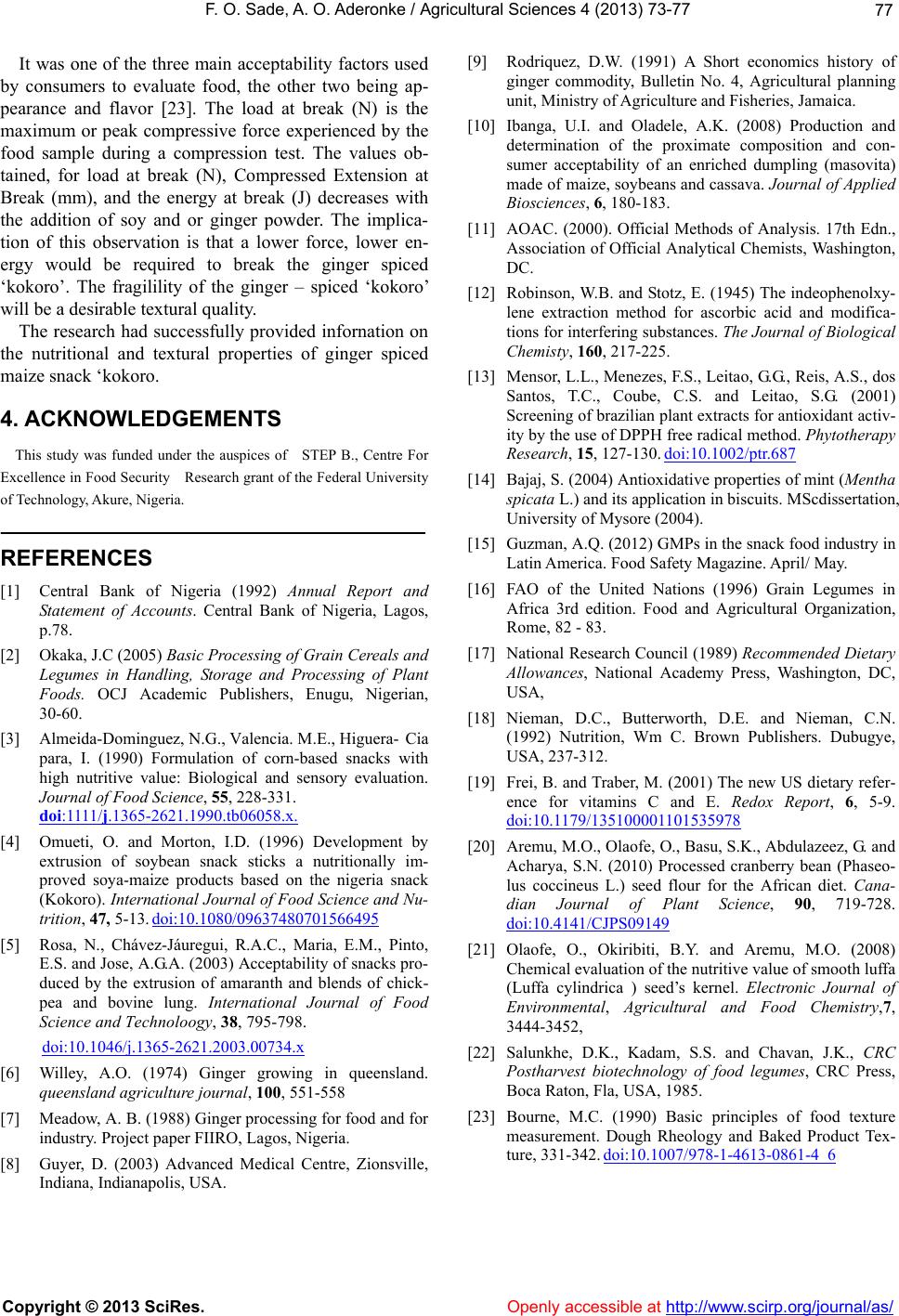
F. O. Sade, A. O. Aderonke / Agricultural Sciences 4 (2013) 73-77
Copyright © 2013 SciRes. http://www.scirp.org/journal/as/
77
[9] Rodriquez, D.W. (1991) A Short economics history of
ginger commodity, Bulletin No. 4, Agricultural planning
unit, Ministry of Agriculture and Fisheries, Jamaica.
It was one of the three main acceptability factors used
by consumers to evaluate food, the other two being ap-
pearance and flavor [23]. The load at break (N) is the
maximum or peak compressive force experienced by the
food sample during a compression test. The values ob-
tained, for load at break (N), Compressed Extension at
Break (mm), and the energy at break (J) decreases with
the addition of soy and or ginger powder. The implica-
tion of this observation is that a lower force, lower en-
ergy would be required to break the ginger spiced
‘kokoro’. The fragilility of the ginger – spiced ‘kokoro’
will be a desirable textural quality.
[10] Ibanga, U.I. and Oladele, A.K. (2008) Production and
determination of the proximate composition and con-
sumer acceptability of an enriched dumpling (masovita)
made of maize, soybeans and cassava. Journal of Applied
Biosciences, 6, 180-183.
[11] AOAC. (2000). Official Methods of Analysis. 17th Edn.,
Association of Official Analytical Chemists, Washington,
DC.
[12] Robinson, W.B. and Stotz, E. (1945) The indeophenolxy-
lene extraction method for ascorbic acid and modifica-
tions for interfering substances. The Journal of Biological
Chemisty, 160, 217-225.
The research had successfully provided infornation on
the nutritional and textural properties of ginger spiced
maize snack ‘kokoro. [13] Mensor, L.L., Menezes, F.S., Leitao, G.G., Reis, A.S., dos
Santos, T.C., Coube, C.S. and Leitao, S.G. (2001)
Screening of brazilian plant extracts for antioxidant activ-
ity by the use of DPPH free radical method. Phytotherapy
Research, 15, 127-130. doi:10.1002/ptr.687
4. ACKNOWLEDGEMENTS
This study was funded under the auspices of STEP B., Centre For
Excellence in Food Security Research grant of the Federal University
of Technology, Akure, Nigeria.
[14] Bajaj, S. (2004) Antioxidative properties of mint (Mentha
spicata L.) and its application in biscuits. MScdissertation,
University of Mysore (2004).
[15] Guzman, A.Q. (2012) GMPs in the snack food industry in
Latin America. Food Safety Magazine. April/ May.
REFERENCES
[16] FAO of the United Nations (1996) Grain Legumes in
Africa 3rd edition. Food and Agricultural Organization,
Rome, 82 - 83.
[1] Central Bank of Nigeria (1992) Annual Report and
Statement of Accounts. Central Bank of Nigeria, Lagos,
p.78.
[17] National Research Council (1989) Recommended Dietary
Allowances, National Academy Press, Washington, DC,
USA,
[2] Okaka, J.C (2005) Basic Processing of Grain Cereals and
Legumes in Handling, Storage and Processing of Plant
Foods. OCJ Academic Publishers, Enugu, Nigerian,
30-60. [18] Nieman, D.C., Butterworth, D.E. and Nieman, C.N.
(1992) Nutrition, Wm C. Brown Publishers. Dubugye,
USA, 237-312.
[3] Almeida-Dominguez, N.G., Valencia. M.E., Higuera-Cia
para, I. (1990) Formulation of corn-based snacks with
high nutritive value: Biological and sensory evaluation.
Journal of Food Science, 55, 228-331.
doi:1111/j.1365-2621.1990.tb06058.x.
[19] Frei, B. and Traber, M. (2001) The new US dietary refer-
ence for vitamins C and E. Redox Report, 6, 5-9.
doi:10.1179/135100001101535978
[4] Omueti, O. and Morton, I.D. (1996) Development by
extrusion of soybean snack sticks a nutritionally im-
proved soya-maize products based on the nigeria snack
(Kokoro). International Journal of Food Science and Nu-
trition, 47, 5-13. doi:10.1080/09637480701566495
[20] Aremu, M.O., Olaofe, O., Basu, S.K., Abdulazeez, G. and
Acharya, S.N. (2010) Processed cranberry bean (Phaseo-
lus coccineus L.) seed flour for the African diet. Cana-
dian Journal of Plant Science, 90, 719-728.
doi:10.4141/CJPS09149
[5] Rosa, N., Chávez-Jáuregui, R.A.C., Maria, E.M., Pinto,
E.S. and Jose, A.G.A. (2003) Acceptability of snacks pro-
duced by the extrusion of amaranth and blends of chick-
pea and bovine lung. International Journal of Food
Science and Technoloogy, 38, 795-798.
doi:10.1046/j.1365-2621.2003.00734.x
[21] Olaofe, O., Okiribiti, B.Y. and Aremu, M.O. (2008)
Chemical evaluation of the nutritive value of smooth luffa
(Luffa cylindrica ) seed’s kernel. Electronic Journal of
Environmental, Agricultural and Food Chemistry,7,
3444-3452,
[22] Salunkhe, D.K., Kadam, S.S. and Chavan, J.K., CRC
Postharvest biotechnology of food legumes, CRC Press,
Boca Raton, Fla, USA, 1985.
[6] Willey, A.O. (1974) Ginger growing in queensland.
queensland agriculture journal, 100, 551-558
[23] Bourne, M.C. (1990) Basic principles of food texture
measurement. Dough Rheology and Baked Product Tex-
ture, 331-342. doi:10.1007/978-1-4613-0861-4_6
[7] Meadow, A. B. (1988) Ginger processing for food and for
industry. Project paper FIIRO, Lagos, Nigeria.
[8] Guyer, D. (2003) Advanced Medical Centre, Zionsville,
Indiana, Indianapolis, USA.
Openly accessible at